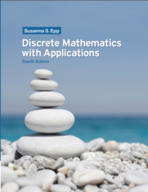Give examples to illustrate the proof of Theorem 1.Theorem
Chapter 5, Problem 28E(choose chapter or problem)
Problem 28E
Give examples to illustrate the proof of Theorem 1.
Theorem 1
Existence and Uniqueness of Binary Integer Representations
Given any positive integer n, n has a unique representation in the form
where r is a nonnegative integer, cr =1, and cj =1 or 0 for all j =0, 1, 2, …,r –1.
Proof:
We give separate proofs by strong mathematical induction to show first the existence and second the uniqueness of the binary representation.
Existence (proof by strong mathematical induction): Let the property P(n) be the equation
where r is a nonnegative integer, cr =1, and cj =1 or 0 for all j =0, 1, 2,…, r –1.
Show that P(1) is true:
Let r = 0 and c0 = 1. Then 1 = cr•2r , and so n = 1 can be written in the required form.
Show that for all integers k≥ 1, if P(i) is true for all integers i from 1 through k,
then P(k+1) is also true:
Let k be an integer with k ≥ 1. Suppose that for all integers i from 1 through k,
where r is a nonnegative integer, cr =1, and cj =1 or 0 for all j =0, 1, 2,…, r –1. We must show that k + 1 can be written as a sum of powers of 2 in the required form.
Case 1 (k + 1 is even): In this case (k + 1)/2 is an integer, and by inductive hypothesis,
since 1 ≤ (k + 1)/2 ≤ k, then,
where r is a nonnegative integer, cr =1, and cj =1 or 0 for all j =0, 1, 2,…, r –1. Multiplying both sides of the equation by 2 gives
which is a sum of powers of 2 of the required form.
Case 2 (k + 1 is odd): In this case k/2 is an integer, and by inductive hypothesis,
since 1 ≤ k/2 ≤ k, then
where r is a nonnegative integer,cr =1, and cj =1 or 0 for all j =0, 1, 2,…, r–1.
Multiplying both sides of the equation by 2 and adding 1 gives
which is also a sum of powers of 2 of the required form.
The preceding arguments show that regardless of whether k + 1 is even or odd, k + 1 has a representation of the required form. [Or, in other words, P(k + 1) is true as was
to be shown.]
[Since we have proved the basis step and the inductive step of the strong mathematical
induction, the existence half of the theorem is true.]
Uniqueness: To prove uniqueness, suppose that there is an integer n with two different representations as a sum of nonnegative integer powers of 2. Equating the two representations and canceling all identical terms gives
where r and s are nonnegative integers, and each ci and each di equal 0 or 1.Without loss of generality, we may assume that r < s. But by the formula for the sum of a geometric sequence (Theorem 2) and because r<s,
Thus
which contradicts equation (5.4.1). Hence the supposition is false, so any integer n has only one representation as a sum of nonnegative integer powers of 2.
Theorem
Sum of a Geometric Sequence
For any real number r except 1, and any integer n ≥ 0,
Proof (by mathematical induction):
Suppose r is a particular but arbitrarily chosen real number that is not equal to 1, and let the property P(n) be the equation
We must show that P(n) is true for all integers n ≥ 0. We do this by mathematicalinduction on n.
Show that P(0) is true:
To establish P(0), we must show that
The left-hand side of this equation is r0 = 1 and the right-hand side is
also because r1 = r and r = 1. Hence P(0) is true.
Show that for all integers k≥ 0, if P(k) is true then P(k+1) is also true:
[Suppose that P(k) is true for a particular but arbitrarily chosen integer k ≥ 0. That is:]
Let k be any integer with k ≥ 0, and suppose that
[We must show that P(k + 1) is true. That is:] We must show that
or, equivalently, that
[We will show that the left-hand side of P(k + 1) equals the right-hand side.]
The left-hand side of P(k + 1) is
which is the right-hand side of P(k + 1) [as was to be shown.]
[Since we have proved the basis step and the inductive step, we conclude that the theorem
is true.]
Unfortunately, we don't have that question answered yet. But you can get it answered in just 5 hours by Logging in or Becoming a subscriber.
Becoming a subscriber
Or look for another answer
